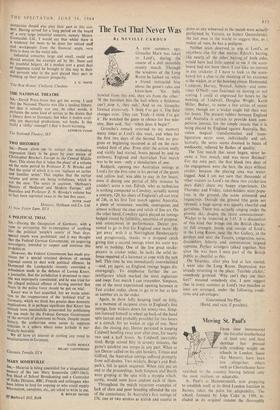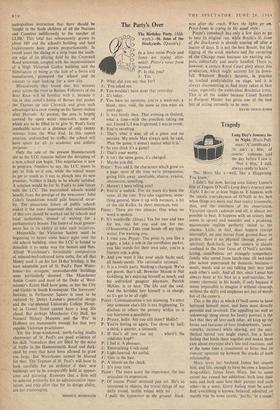Moving St. Paul's
St. Paul's at Hammersmith, now preparing to establish itself at its. third London location in Barnes, takes the palm for adaptability. The school, founded by John Colet in 1509, in- cluded in its original statutes the thoroughly
metropolitan instruction that there should be 'taught in the Scole children of all the Nacions and Countres indifferently to the number of CUM' This total has subsequently grown to about 680 and the school's building and land requirements have grown proportionately. In recent years the slicing of a strip from the south- ern edge of its playing field by the Cromwell Road extension, coupled with the inconveniences of a High Victorian Gothic building and the humiliation of being at the hub of a Swiss roll manufacture, prompted the school and its trustees to start looking for a new site.
Miraculously they found one, five minutes away across the river in Barnes. Followers of the Boat Race will be familiar with it, because it lies in that camel's hump of Barnes that pushes the Thames up into Chiswick and gives such advantages to a crew rowing on the Surrey station after Harrods. At present, the area is largely covered by open water reservoirs, some of which are to be filled in to give St. Paul's forty invaluable acres at a distance of only twenty minutes from the West End. In this superb position, undisturbed by traffic, the school will have space for all its academic and athletic purposes.
Only the sale of the present Hammersmith site to the LCC remains before the designing of a new ,school can begin. This negotiation is now in progress. Needless to say, the LCC wants to pay as little as it can, while the school wants to get as much as it can to plough into its new premises. Neither is likely to be wholly satisfied. A solution would be for St. Paul's to join forces with the LCC. The maintained schools would benefit from the prestige of the newcomer; John Colet's foundation would gain financial secur- ity. The precarious future of public schools makes it the more important that relationships of this sort should be worked out by schools and local authorities, instead of waiting for a parliamentary broom. The future of local govern- ment lies in its ability to take such initiatives.
Meanwhile, the Victorian Society must be beginning to heave some heavy sighs over the old school building, since the LCC is bound to demolish it to make way for houses and flats. Alfred Waterhouse's formidable composition of minced-beef-coloured terra cotta, for all that Monty used it on his last D-day briefing, is the least adaptable part of St. Paul's. Poor Water- house—his arrogant, unweatherable buildings seem particularly doomed. The Manchester Assize Courts and most of the Duke of West- minster's Eaton Hall have gone, so has the City and Guilds in South Kensington. The Surveyors' Institute in Parliament Square is soon to be _replaced by Denys 'Lasdun's powerful design and the star-planned University College Hospi- tal in Gower Street cannot have a long Life ahead. But perhaps Manchester City Hall, the Natural History Museum and the `Pru' in Holborn are monuments enough for that very capable Victorian practitioner.
Yet the large-windowed, north-facing. studio classrooms of St. Paul's are good evidence of his skill. Nowadays they are filled by the noise of traffic in the Hammersmith Road and dark- ened by trees that have been allowed to grow too large. But Waterhouse cannot be blamed for that. The Trustees of St. Paul's will have to look carefully for an architect if their new buildings are to be comparably bold in appear- ance and planning. Rumours that, a firm will be selected primarily for its administrative repu- tation, and only after that for its design ability, are not encouraging.
TERENCE BENDIXSON



































 Previous page
Previous page